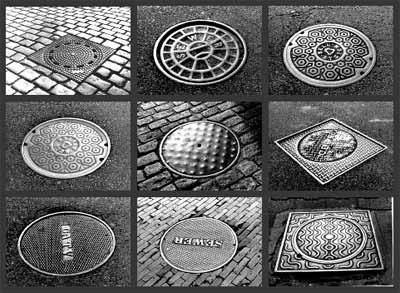Marking time in January 2002
More manhole covers
German photographer Roland Mühler’s website includes a gallery of fine photographs of street manhole covers. Remember my snapshot of the one in Chandigarh? Roland’s are much nicer (and there are 45 of them).

Something the web is good for
This web page explains how walking beams work, to transfer a rotary motion up the mountain, over great distances. It uses a Java applet to make an animated diagram of an eighteenth century mining machine. With your mouse you can operate the machine, and try different sizes of rods, levers and wheels.
More on Counterpunch
I finished reading Fred Smeijers’ Counterpunch: making type in the sixteenth century, designing typefaces now, which I already mentioned here (20 and 25 December). The book was good to the end, so I have written a little review for the ironic column.
Sumo aprons in triplicate
See this photo essay on the retirement ceremony for Akebono, the Japanese sumo champion. Akebono was born in Hawaii of Irish-Hawaiian and Cuban-Hawaiian parents. He was the biggest yokozuma (203cm, 233kg), and the first foreigner to gain this rank. The emotional climax of the ceremony was the cutting of the champ’s topnot, involving 300 VIPs. Read closely to discover why yokozumas have aprons in sets of three.
Piet Mondrian, who lacked green
For refreshment, see this art work by Dan Flavin entitled greens crossing greens (to Piet Mondrian who lacked green). Mondrian is said to have been probably incapable of irony and might not have got the joke.
Why a Strad sounds so good
Dr Joseph Nagyvary attributes the brilliant sound of Antonio Stradivari’s violins to borax and alum, used as insecticides.
‘These chemicals were prescribed and made by the local drugstore chemist for wood treatment, and they were used by Stradivari and the other violin makers,’ Dr. Nagyvary said. ‘They did not intend it for the improvement of the sound, and that was just an accident or fringe benefit which they were not aware of at all.’
Lumberjacks in wetsuits
The Superior Water-Logged Lumber Co., Inc. of Ashland, Wisconsin, makes a business of pulling sunken logs out of lakes and rivers. Some of this old-growth birch, oak and maple escaped from log rafts and sank more than a hundred years ago. The company promotes the timber for making musical instruments, because of its colour and density, and because of the effects of its long immersion:
As wood is soaked in water, certain changes take place on a cellular level. Anaerobic bacteria eat away at the hemicellulose/ peltic substances in the wood, along with a certain amount of starchy matter. In essence what this means is that all of the heavy material which would otherwise dampen acoustic vibrations (or sound) are removed from the equation by these anaerobic organisms. This effectively provides the instrument with a more responsive acoustic plate. Most modern builders demand older or “seasoned” wood for their instruments since the use of older wood allows the substances mentioned above to crystallize and harden over time. However it is exceedingly more effective if these substances are consumed by bacteria. As an interesting sidelight, I would like to point out that as “off the stump” wood dries, the cell openings close and deform. However when water-logged wood dries, the cell walls remain open—thus dramatically enhancing the velocity of sound.
![]()
Well building blogging hath three conditions…
Here’s part of an interview with Evan Williams of blogger:
To me, the blog concept is about three things: Frequency, Brevity, and Personality. These are the three characteristics that I believe are the driving factors in weblogs’ popularity as a publishing format. This clarification has evolved over time, but I realized early on that what was significant about blogs was the format—not the content.
World Trade Centre: the Mecca connection
This piece points out the architect Minoru Yamasaki’s connections with the Saudi royal family, and with major Saudi building projects. On top of the World Trade Centre’s standing as an icon of global capital, here are some other reasons for Osama Bin Laden to hate the place.